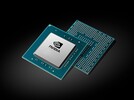NVIDIA Quadro T2000 Max-Q vs NVIDIA Quadro T1000 Max-Q vs NVIDIA T1000
NVIDIA Quadro T2000 Max-Q
► remove from comparisonThe Nvidia Quadro T2000 with Max-Q Design is a professional mobile graphics card that is based on the Turing architecture (TU117 chip). It is based on the consumer desktop GTX 1650 Ti therefore currently between a mobile GTX 1650 and GTX 1660 Ti. The chip is manufactured in 12nm FinFET at TSMC. Compared to the normal Quadro T2000, the Max-Q variants are clocked lower and work in a more efficient state. Currently, we know of two variants with different clock speeds and power consumptions (35 and 40 W).
| Model | Shader | TGP (W) | Base (MHz) | Boost (MHz) |
| Quadro T2000 Mobile | 1024 | 60 | 1575 | 1785 |
| Quadro T2000 Max-Q | 1024 | 40 | 1200 | 1620 |
| Quadro T2000 Max-Q | 1024 | 35 | 930 | 1500 |
| GeForce GTX 1650 Ti (Desktop) | 1024 | 75? | 1530 | 1725 |
| GeForce GTX 1660 Ti Mobile | 1536 | 80 | 1455 | 1590 |
| GeForce GTX 1650 Mobile | 896 | 50 | 1395 | 1560 |
The Turing generation did not only introduce raytracing for the RTX cards, but also optimized the architecture of the cores and caches. According to Nvidia the CUDA cores offer now a concurrent execution of floating point and integer operations for increased performance in compute-heavy workloads of modern games. Furthermore, the caches were reworked (new unified memory architecture with twice the cache compared to Pascal). This leads to up to 50% more instructions per clock and a 40% more power efficient usage compared to Pascal.
The performance in professional apps should be clearly lower than a normal (Max-P) Quadro T2000 due to the lower clock speeds, but still ahead the slower Quadro T1000 due to the higher shader count. Compared to consumer cards, the mobile GTX 1650 should be still slower.
Thanks to the relative low power consumption of the Quadro T2000 Max-Q, the GPU is suited for thin and light laptops. The used TU116 chip is manufactured in 12nm FFN at TSMC.
NVIDIA Quadro T1000 Max-Q
► remove from comparison
The Nvidia Quadro T1000 with Max-Q Design is a professional mobile graphics card that is based on the Turing architecture (TU117 chip). Compared to the consumer GTX 1650, the Quadro T1000 features less CUDA cores / shaders (768 versus 896). The chip is manufactured in 12nm FinFET at TSMC. Compared to the normal Quadro T1000, the Max-Q variants are clocked lower and work in a more efficient state. Currently, we know of two variants with different clock speeds and power consumptions (35 and 40 W).
| Model | Shader | TGP (W) | Base (MHz) | Boost (MHz) |
| Quadro T1000 Mobile | 768 | 50 | 1395 | 1455 |
| Quadro T1000 Max-Q | 768 | 40 | 1230 | 1455 |
| Quadro T1000 Max-Q | 768 | 35 | 795 | 1455 |
| Quadro T2000 Mobile | 1024 | 60 | 1575 | 1785 |
| GeForce GTX 1650 Mobile | 896 | 50 | 1395 | 1560 |
The Quadro T1000 is a mobile graphics card that is based on the Turing architecture (TU116 chip). Compared to the faster RTX 2000 GPUs (e.g. RTX 2060), the T1000 integrates no Raytracing or Tensor cores. Due to the same boost clock as the mobile T1000, the Max-Q variants can perform similar with sufficient cooling.
The Turing generation did not only introduce raytracing for the RTX cards, but also optimized the architecture of the cores and caches. According to Nvidia the CUDA cores offer now a concurrent execution of floating point and integer operations for increased performance in compute-heavy workloads of modern games. Furthermore, the caches were reworked (new unified memory architecture with twice the cache compared to Pascal). This leads to up to 50% more instructions per clock and a 40% more power efficient usage compared to Pascal.
Thanks to the low power consumption, the Max-Q T2000 GPU can be used in thin and light laptops. The used TU116 chip is manufactured in 12nm FFN at TSMC.
NVIDIA T1000
► remove from comparisonThe Nvidia T1000 is a professional desktop graphics card for small entry-level workstations. It is based on the same TU117 Turing chip as the consumer GeForce GTX1650. The number of shader units is also identical at 896. With 8 GB VRAM, the Nvidia T1000 however offers more VRAM, which is still connected via a 128 bit memory bus. The power consumption of the Nvidia T1000 is only rated at 50 watts and therefore does not require an additional power connection.
The professional graphics cards offer certified drivers which are optimized for stability and performance in professional applications (CAD, DCC, medical, prospecting, visualization applications). As a result, the performance in these areas is significantly better compared to consumer graphics cards with the same chip.
In contrast to the more powerful RTX cards (e.g. Quadro RTX 3000), they do not offer ray tracing and tensor cores. The Turing architecture has also seen significant improvements at the CUDA core level. Float and INT operations can now be executed simultaneously, the cache has been standardized and improved and adaptive shading has been introduced. As a result, Nvidia claims up to 50% higher performance per core compared to Pascal.
| NVIDIA Quadro T2000 Max-Q | NVIDIA Quadro T1000 Max-Q | NVIDIA T1000 | ||||||||||||||||||||||||||||||||||||||||||||||||||||||||||||||||||||||||||||||||||||||||||||||||||||||||||||||||||||||||||||||||||||||||||||||||||||||||||
| Quadro Turing Series |
|
|
| |||||||||||||||||||||||||||||||||||||||||||||||||||||||||||||||||||||||||||||||||||||||||||||||||||||||||||||||||||||||||||||||||||||||||||||||||||||||||
| Codename | N19P-Q3 MAX-Q | N19P-Q1 | ||||||||||||||||||||||||||||||||||||||||||||||||||||||||||||||||||||||||||||||||||||||||||||||||||||||||||||||||||||||||||||||||||||||||||||||||||||||||||
| Architecture | Turing | Turing | Turing | |||||||||||||||||||||||||||||||||||||||||||||||||||||||||||||||||||||||||||||||||||||||||||||||||||||||||||||||||||||||||||||||||||||||||||||||||||||||||
| Pipelines | 1024 - unified | 768 - unified | 896 - unified | |||||||||||||||||||||||||||||||||||||||||||||||||||||||||||||||||||||||||||||||||||||||||||||||||||||||||||||||||||||||||||||||||||||||||||||||||||||||||
| Core Speed | 930 / 1200 - 1500 / 1620 (Boost) MHz | 795 / 1230 - 1455 (Boost) MHz | 1065 - 1395 (Boost) MHz | |||||||||||||||||||||||||||||||||||||||||||||||||||||||||||||||||||||||||||||||||||||||||||||||||||||||||||||||||||||||||||||||||||||||||||||||||||||||||
| Memory Speed | 8000 MHz | 8000 MHz | 10000 effective = 1250 MHz | |||||||||||||||||||||||||||||||||||||||||||||||||||||||||||||||||||||||||||||||||||||||||||||||||||||||||||||||||||||||||||||||||||||||||||||||||||||||||
| Memory Bus Width | 128 Bit | 128 Bit | 128 Bit | |||||||||||||||||||||||||||||||||||||||||||||||||||||||||||||||||||||||||||||||||||||||||||||||||||||||||||||||||||||||||||||||||||||||||||||||||||||||||
| Memory Type | GDDR5 | GDDR5 | GDDR6 | |||||||||||||||||||||||||||||||||||||||||||||||||||||||||||||||||||||||||||||||||||||||||||||||||||||||||||||||||||||||||||||||||||||||||||||||||||||||||
| Max. Amount of Memory | 4 GB | 4 GB | 8 GB | |||||||||||||||||||||||||||||||||||||||||||||||||||||||||||||||||||||||||||||||||||||||||||||||||||||||||||||||||||||||||||||||||||||||||||||||||||||||||
| Shared Memory | no | no | no | |||||||||||||||||||||||||||||||||||||||||||||||||||||||||||||||||||||||||||||||||||||||||||||||||||||||||||||||||||||||||||||||||||||||||||||||||||||||||
| API | DirectX 12_1, OpenGL 4.6 | DirectX 12_1, OpenGL 4.6 | DirectX 12_1, Shader 6.8, OpenGL 4.6, OpenCL 3.0, Vulkan 1.3 | |||||||||||||||||||||||||||||||||||||||||||||||||||||||||||||||||||||||||||||||||||||||||||||||||||||||||||||||||||||||||||||||||||||||||||||||||||||||||
| Power Consumption | 35 - 40 Watt | 35 - 40 Watt | 50 Watt | |||||||||||||||||||||||||||||||||||||||||||||||||||||||||||||||||||||||||||||||||||||||||||||||||||||||||||||||||||||||||||||||||||||||||||||||||||||||||
| Transistors | 4.7 Billion | 4.7 Billion | ||||||||||||||||||||||||||||||||||||||||||||||||||||||||||||||||||||||||||||||||||||||||||||||||||||||||||||||||||||||||||||||||||||||||||||||||||||||||||
| technology | 12 nm | 12 nm | 12 nm | |||||||||||||||||||||||||||||||||||||||||||||||||||||||||||||||||||||||||||||||||||||||||||||||||||||||||||||||||||||||||||||||||||||||||||||||||||||||||
| Notebook Size | medium sized | medium sized | ||||||||||||||||||||||||||||||||||||||||||||||||||||||||||||||||||||||||||||||||||||||||||||||||||||||||||||||||||||||||||||||||||||||||||||||||||||||||||
| Date of Announcement | 27.05.2019 | 27.05.2019 | 06.05.2021 | |||||||||||||||||||||||||||||||||||||||||||||||||||||||||||||||||||||||||||||||||||||||||||||||||||||||||||||||||||||||||||||||||||||||||||||||||||||||||
| TMUs | 56 | |||||||||||||||||||||||||||||||||||||||||||||||||||||||||||||||||||||||||||||||||||||||||||||||||||||||||||||||||||||||||||||||||||||||||||||||||||||||||||
| ROPs | 32 | |||||||||||||||||||||||||||||||||||||||||||||||||||||||||||||||||||||||||||||||||||||||||||||||||||||||||||||||||||||||||||||||||||||||||||||||||||||||||||
| Theoretical Performance | 5000 TFLOPS FP16, 2500 TFLOPS FP32, 0.7812 TFLOPS FP64 | |||||||||||||||||||||||||||||||||||||||||||||||||||||||||||||||||||||||||||||||||||||||||||||||||||||||||||||||||||||||||||||||||||||||||||||||||||||||||||
| Memory Bandwidth | 160 GB/s | |||||||||||||||||||||||||||||||||||||||||||||||||||||||||||||||||||||||||||||||||||||||||||||||||||||||||||||||||||||||||||||||||||||||||||||||||||||||||||
| Die Size | 200 mm² | |||||||||||||||||||||||||||||||||||||||||||||||||||||||||||||||||||||||||||||||||||||||||||||||||||||||||||||||||||||||||||||||||||||||||||||||||||||||||||
| PCIe | 3.0 x16 | |||||||||||||||||||||||||||||||||||||||||||||||||||||||||||||||||||||||||||||||||||||||||||||||||||||||||||||||||||||||||||||||||||||||||||||||||||||||||||
| Displays | 4 Displays (max.), DisplayPort 1.4a |
Benchmarks
3DM Vant. Perf. total + NVIDIA Quadro T2000 Max-Q
specvp12 sw-03 + NVIDIA Quadro T2000 Max-Q
Cinebench R15 OpenGL 64 Bit + NVIDIA Quadro T2000 Max-Q
GFXBench T-Rex HD Offscreen C24Z16 + NVIDIA Quadro T2000 Max-Q
Average Benchmarks NVIDIA Quadro T2000 Max-Q → 0% n=0
Average Benchmarks NVIDIA T1000 → 0% n=0
* Smaller numbers mean a higher performance
1 This benchmark is not used for the average calculation
Game Benchmarks
The following benchmarks stem from our benchmarks of review laptops. The performance depends on the used graphics memory, clock rate, processor, system settings, drivers, and operating systems. So the results don't have to be representative for all laptops with this GPU. For detailed information on the benchmark results, click on the fps number.

Total War Pharaoh
2023
Baldur's Gate 3
2023
F1 23
2023
GRID Legends
2022
God of War
2022
Far Cry 6
2021
F1 2020
2020
Gears Tactics
2020
Doom Eternal
2020
Hunt Showdown
2020
GRID 2019
2019
Borderlands 3
2019
Control
2019
Anno 1800
2019
Dirt Rally 2.0
2019
Far Cry New Dawn
2019
Metro Exodus
2019
Apex Legends
2019
Far Cry 5
2018
X-Plane 11.11
2018
Dota 2 Reborn
2015
The Witcher 3
2015
GTA V
2015
BioShock Infinite
2013Average Gaming NVIDIA Quadro T2000 Max-Q → 100%
Average Gaming 30-70 fps → 100%
Average Gaming NVIDIA T1000 → 122%
Average Gaming 30-70 fps → 106%
| NVIDIA Quadro T2000 Max-Q | NVIDIA Quadro T1000 Max-Q | NVIDIA T1000 | |||||||||||||||||||
|---|---|---|---|---|---|---|---|---|---|---|---|---|---|---|---|---|---|---|---|---|---|
| low | med. | high | ultra | QHD | 4K | low | med. | high | ultra | QHD | 4K | low | med. | high | ultra | QHD | 4K | ||||
| F1 24 | 98.4 | 82.6 | 58.8 | ||||||||||||||||||
| Avatar Frontiers of Pandora | 22 | 19 | 15 | 10 | |||||||||||||||||
| Total War Pharaoh | 138.6 | 90.8 | 50.6 | 39.8 | |||||||||||||||||
| Assassin's Creed Mirage | 44 | 40 | 38 | ||||||||||||||||||
| Cyberpunk 2077 2.2 Phantom Liberty | 45.1 | 34.2 | 28.3 | 23.8 | |||||||||||||||||
| Baldur's Gate 3 | 45 | 35.2 | 30.2 | 29.5 | |||||||||||||||||
| F1 23 | 108.3 | 96.5 | 63.6 | ||||||||||||||||||
| Tiny Tina's Wonderlands | 69.2 | 55.6 | 35.3 | 27.6 | |||||||||||||||||
| GRID Legends | 125.4 | 91.3 | 69.6 | 49.7 | |||||||||||||||||
| God of War | 51.8 | 42.5 | 33.5 | 21.4 | |||||||||||||||||
| Far Cry 6 | 110.4 | 56.9 | 47.4 | 40.3 | |||||||||||||||||
| Borderlands 3 | 123.4 | 56 | 35.8 | 27.3 | 151 | 60 | 38.2 | 28.6 | |||||||||||||
| Total War: Three Kingdoms | 148.4 | 60.3 | 36.3 | 24.4 | 195.9 | 60 | 37.3 | 24.1 | |||||||||||||
| Far Cry New Dawn | 83 | 58 | 55 | 50 | 117 | 62 | 58 | 53 | |||||||||||||
| Metro Exodus | 91.5 | 41.74 | 31.2 | 24.6 | 102.3 | 45.9 | 33 | 26.1 | |||||||||||||
| Strange Brigade | 226 | 87.2 | 69.4 | 59.9 | |||||||||||||||||
| Far Cry 5 | 127 | 62 | 57 | 53 | |||||||||||||||||
| X-Plane 11.11 | 96 | 82 | 69 | 47.2 | 211 | 145.8 | 130.1 | ||||||||||||||
| Final Fantasy XV Benchmark | 91 | 45 | 33 | 25.7 | 13 | 101.3 | 49.3 | 36.2 | |||||||||||||
| Dota 2 Reborn | 149 | 136 | 124 | 113 | 46 | 246.2 | 217.7 | 150.4 | 136.5 | ||||||||||||
| The Witcher 3 | 181 | 107.6 | 62.5 | 33 | 188.8 | 113.8 | 63.9 | 35.2 | |||||||||||||
| GTA V | 187.4 | 187.1 | 103.5 | 50.2 | |||||||||||||||||
| NVIDIA Quadro T2000 Max-Q | NVIDIA Quadro T1000 Max-Q | NVIDIA T1000 | |||||||||||||||||||
| low | med. | high | ultra | QHD | 4K | low | med. | high | ultra | QHD | 4K | low | med. | high | ultra | QHD | 4K | < 30 fps < 60 fps < 120 fps ≥ 120 fps | 4 4 | 4 3 1 | 5 2 1 | 3 2 1 | 1 | 1 2 | < 30 fps < 60 fps < 120 fps ≥ 120 fps | | | | | | | < 30 fps < 60 fps < 120 fps ≥ 120 fps | 1 4 7 10 | 1 8 10 3 | 2 13 5 2 | 8 8 1 | | |
For more games that might be playable and a list of all games and graphics cards visit our Gaming List






















